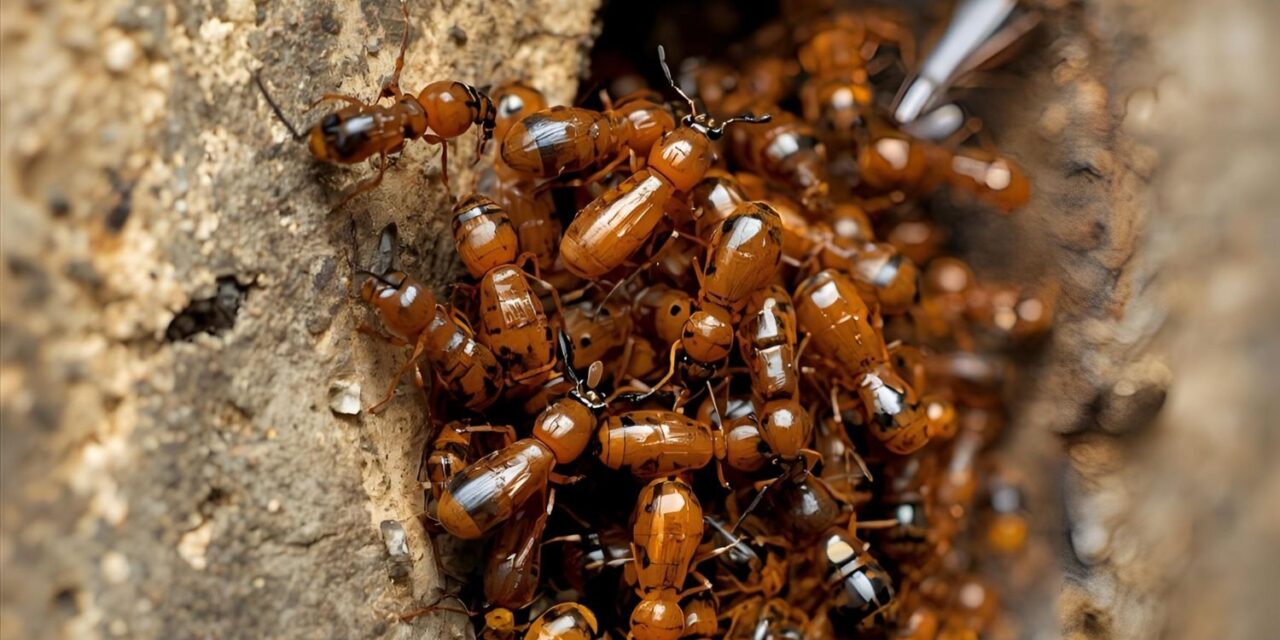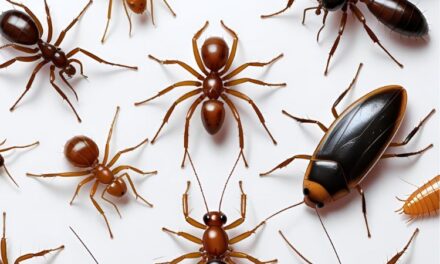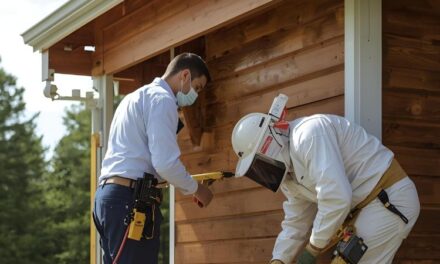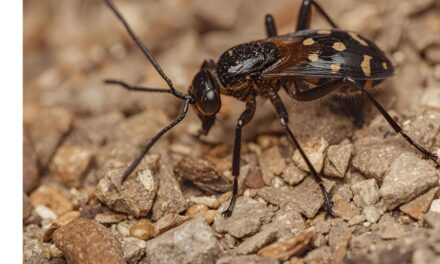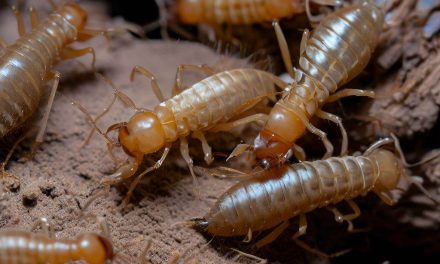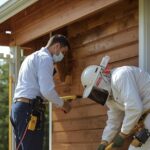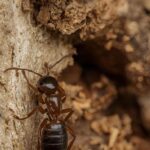Estimated reading time: 9 minutes
Key Takeaways
-
- Termites pose a *significant, silent threat* to properties across India, causing substantial financial damage.
-
- Three primary types of termites – *Subterranean, Drywood, and Dampwood* – are prevalent, each with unique behaviors and habitats.
-
- *Accurate identification* of the termite species is the crucial first step for effective control and protection strategies.
-
- Look for distinct signs like *mud tubes* (subterranean), *hexagonal frass* (drywood), or *moisture-damaged wood* (dampwood) to identify infestations.
-
- Ignoring termite signs can lead to *extensive, hidden structural damage*, making early detection and professional intervention vital.
- Professional *pest control experts* are essential for proper diagnosis, species-specific treatment, and safeguarding your property long-term.
Table of contents
Termites are a silent but formidable threat in homes and buildings across India. These tiny, often unseen creatures can cause monumental damage, leading to significant financial losses. Understanding the different types of termites found in the country is the first step towards effective protection.
In India, the threat posed by termites in India to wooden structures, furniture, and paper-based materials is both significant and pervasive. These destructive insects are responsible for an estimated annual damage running into crores of rupees. They are rightly called “silent destroyers” because their activities are concealed, making early detection incredibly challenging for property owners.
India’s vast and diverse climatic conditions, ranging from the humid coastal regions to the dry inland areas, provide ideal environments for various types of termites to thrive. Each termite species has unique biological traits, behaviors, and infestation patterns. This means that a “one-size-fits-all” approach to their control simply won’t work.
It is critically important to understand the specific types of termites prevalent in different parts of the country. Their unique characteristics directly impact the effectiveness of any chosen control and eradication strategies. Without proper identification, efforts to get rid of them can be wasted, allowing the damage to worsen.
This essential guide will explore the major termite classifications found in India. We will focus on their unique characteristics, preferred habitats, and the tell-tale signs of their presence. Our goal is to empower you, the reader, to identify and address termite threats effectively, safeguarding your valuable property.
Subterranean Termites – The Ground Dwellers
When we talk about destructive pests, subterranean termites often come to mind first. These are, without a doubt, the most destructive and widespread group of termites in India. Their survival depends on one fundamental requirement: consistent contact with soil or a reliable moisture source. This connection allows them to maintain the high humidity levels they need to live.
Characteristics & Habitat of Subterranean Termites
Subterranean termite colonies are marvels of insect architecture. They construct intricate tunnel systems, famously known as mud tubes or shelter tubes. These tubes are built meticulously from a mixture of soil particles, wood, and their own saliva.
The purpose of these mud tubes is vital for the colony’s survival. They allow the termites to travel unseen between their underground nests and their above-ground food sources. These protective tunnels also shield them from predators like ants and prevent them from drying out (desiccation) in the open air.
The colonies of subterranean termites are vast, often numbering in the millions. Within these immense colonies, a distinct caste system ensures the smooth functioning of the group:
- Workers: These are the most numerous termites. They are responsible for foraging for food (cellulose-based materials), building and maintaining the tunnels, and feeding the entire colony, including the queen, king, and young.
- Soldiers: With their large, often dark heads and powerful mandibles (jaws), soldiers are dedicated to defending the colony from threats.
- Reproductives: This caste includes the king, queen, and supplemental reproductives. The queen is the primary egg-layer, responsible for the colony’s growth and survival.
Prevalence of Subterranean Termites in India
Subterranean termites are truly ubiquitous across India. They can be found in almost all states and union territories, making them a nationwide concern. They are particularly prevalent in areas that offer high humidity, consistent moisture, and readily available wood that is buried or in direct contact with the ground.
Common destructive species found in India include various termites from the genera Odontotermes (for example, *Odontotermes obesus* and *Odontotermes feae*), *Coptotermes* (such as *Coptotermes heimi*), and *Microtermes*. These specific species are well-adapted to the Indian environment and are major agricultural pests. Beyond crops, they are also significant destroyers of buildings and homes throughout the country.
Their widespread impact on both agriculture and infrastructure highlights their status as one of India’s most economically damaging pests.
*(Source: Indian Council of Agricultural Research – National Bureau of Agricultural Insect Resources)*
Signs of Infestation: Key Indicators of Subterranean Termites
Detecting subterranean termites early is crucial to limit their destructive potential. Here are the key indicators to look for:
- Mud Tubes (Shelter Tubes): These are the most definitive sign of subterranean termites. They are pencil-thick, earthen tunnels found on foundations, walls, wooden beams, or even plumbing pipes. The presence of these tunnels unequivocally indicates that termites are traveling unseen from their underground colony to their food source (your wood). They protect the termites from dry air and predators.
- Discarded Wings: After swarmers (winged reproductives) emerge from the colony during specific seasons, often just before or during the monsoon, they shed their wings. You might find these delicate, transparent wings piled near windowsills, light fixtures, or caught in spiderwebs. This is a clear sign that a termite colony is established nearby.
- Damaged Wood: Wood infested by subterranean termites will often sound hollow when tapped. You might also notice areas that appear darkened or blistered. These termites primarily eat the soft, springwood layers within the wood, leaving behind intricate tunnels that meticulously follow the wood grain. The outer surface often remains intact, making the damage hard to spot initially.
- Sagging Floors or Ceilings: In cases of severe and prolonged infestations, the structural wood supporting floors or ceilings can be severely compromised. This can lead to visible sagging or unevenness, indicating extensive damage beneath the surface.
- Frass (Fecal Matter): While not as distinct or common as with drywood termites, some subterranean species might leave small, dark fecal matter, especially if they are excavating through plaster or drywall. However, it’s generally less visible and often mixed with mud or soil.
Nature of Damage Caused by Subterranean Termites
The damage caused by subterranean termites is extensive and often insidious. They specialize in hollowing out wooden elements from the inside out. This includes:
- Wooden beams and supports
- Floorboards
- Door and window frames
- Furniture
They often leave only a thin veneer of wood or paint intact on the surface. This cunning behavior allows the damage to go unnoticed for long periods, leading to a severe compromise in the structural integrity of buildings. Beyond structural wood, subterranean species also infest books, important documents, and other cellulosic materials, destroying valuable possessions.
Drywood Termites – The Wood Burrowers
Unlike their subterranean cousins, drywood termites do not require any contact with the soil. This crucial difference sets them apart and dictates their habitat and the signs of their presence. These termites live entirely within the wood they infest, deriving all their moisture needs from the wood itself and the surrounding atmosphere. They are true “wood burrowers,” making their home directly inside your timber.
Characteristics & Habitat of Drywood Termites
Drywood termites form much smaller colonies compared to subterranean termites. Typically numbering in the thousands, rather than millions, their colonies also grow at a much slower pace.
They have a preference for sound, dry wood. You will often find them infesting:
- Attics
- Furniture
- Structural timbers that are not in contact with the ground, such as roof rafters or upper-floor joists.
Their ability to live within dry wood makes them particularly problematic for wooden artifacts, antique furniture, and even books.
Prevalence of Drywood Termites in India
While less common and generally less destructive than subterranean termites in India on a nationwide scale, drywood termites are significant pests in specific regions.
They are predominantly found in coastal areas, arid regions, and states with warmer climates. This includes states like Gujarat, Maharashtra, Karnataka, Goa, and parts of Tamil Nadu and Andhra Pradesh. These regions provide the suitable humidity levels for their survival within wood.
Their presence is often linked to infested furniture or other wooden articles that have been transported from one region to another. This movement facilitates their spread, allowing them to establish new colonies far from their original homes. A common genus of drywood termites found in India is *Cryptotermes*, with species like *Cryptotermes cavifrons* and *Cryptotermes havilandi* being notable examples.
*(Source: Termite Fauna of India: A Review of Diversity and Distribution)*
Signs of Infestation: Key Indicators of Drywood Termites
Identifying drywood termites requires looking for signs distinct from subterranean species.
- Fecal Pellets (“Frass”): This is the most characteristic and definitive sign of drywood termites. Their fecal pellets are distinctive: hard, hexagonal-shaped, and often resemble sawdust or tiny sand grains. These termites push the pellets out from small “kick-out holes” in the infested wood.
- Accumulation: You will typically find these pellets accumulating in small, neat piles directly below the infested site. The color of the frass can vary depending on the type of wood the termites have consumed.
- Kick-out Holes (detailed): These are tiny, perfectly round holes, often the size of a pinhead, in the surface of the infested wood. These holes serve as exits for expelling the drywood termite frass. When not in use, the termites often seal these holes, making them difficult to spot without close inspection.
- Swarmers: Winged reproductives of drywood termites are often seen swarming directly from the infested wood itself, typically during daytime and specific seasons. Unlike subterranean swarmers who shed wings after flight, drywood swarmers might still have their wings when found or shed them very close to the infested spot.
- Damaged Wood: When you examine wood infested by drywood termites, their galleries (tunnels) will appear smoother and entirely free of soil or mud. They excavate across the grain of the wood, creating large, clean chambers connected by smaller tunnels. The infested wood may sound hollow when tapped, similar to subterranean damage, but crucially, there will be no mud tubes present.
Nature of Damage Caused by Drywood Termites
The damage caused by drywood termites is often localized but can be quite severe, particularly for cherished items. They infest:
- Wooden furniture, including antique pieces.
- Decorative wooden elements.
- Door and window frames.
- Structural timbers, especially in upper stories of buildings where moisture contact is minimal.
While their colonies are smaller, their continuous feeding can lead to the hollowing out of large sections within the wood. This can potentially compromise the structural integrity of compromised wooden items, leading to breakage or collapse if left untreated. Because they don’t require soil contact, they can be introduced into a home simply by bringing in an already infested piece of furniture.
Dampwood Termites – The Moisture Seekers
Dampwood termites are the largest of the termite species found in India. Their defining characteristic is a strong preference for wood with high moisture content. They are almost exclusively found in decaying wood or wood that is infested with fungus. Their need for moisture is paramount to their survival.
These termites differ significantly from both subterranean and drywood species. Unlike subterranean termites, they do not build tell-tale mud tubes. And unlike drywood termites, their frass (fecal pellets) is less distinctive and often clumped together or entirely absent, as they prefer moist environments where pellets can decompose. Dampwood termites typically seal themselves entirely within the infested wood, making their presence hard to spot from the outside.
Distribution and Environmental Conditions in India for Dampwood Termites
Dampwood termites in India are generally less prevalent as structural pests in urban areas compared to the widespread subterranean termites. However, they are common in forested areas and specific regions where consistent sources of moisture are present.
Species examples found in India include *Neotermes bosei* and *Neotermes gardneri*. These species thrive in conditions where wood is consistently damp.
*(Source: Zoological Survey of India)*
Crucially, the presence of dampwood termites in homes is almost always an indicator of underlying moisture problems. These issues might include:
- Water leaks from pipes or roofs.
- Poor drainage around the foundation.
- Leaky plumbing.
- Wood-to-ground contact that allows absorption of ground moisture.
They thrive in damp, poorly ventilated areas like basements, crawl spaces, or within dead trees and stumps. Addressing these moisture issues is often the first and most important step in controlling a dampwood termite infestation.
Key Indicators of Dampwood Termite Presence
Identifying dampwood termites often involves a combination of visual cues and an understanding of moisture conditions.
- Soft, Moist Wood: The most direct indicator is wood that visibly appears water-damaged, soft, and spongy to the touch. This high moisture content is what attracts these termites.
- Visible Tunnels: When infested wood is broken open, you will often see large, smooth, and clean tunnels or galleries within the wood. These tunnels can follow the grain but sometimes cross it, indicating extensive excavation. There will be no soil or mud within these galleries.
- Large Fecal Pellets: Their fecal pellets are larger than the distinct drywood frass. They are often irregular in shape, and due to the moist environment, they may stick to the gallery walls or be expelled in piles that resemble sawdust. However, these piles are typically moist, often dark, and can be less numerous or noticeable than drywood frass.
- Presence of Swarmers: Winged adult dampwood termites are notably large. They may be seen emerging directly from infested wood, especially in areas with high humidity. Their size can be a key distinguishing factor.
Nature of Dampwood Termite Damage
Dampwood termites inflict significant dampwood termite damage on compromised wooden elements that are exposed to excessive moisture. This includes:
- Rotting logs and tree stumps.
- Fence posts and utility poles.
- Any structural wood in homes that suffers from chronic water intrusion, such as wood near leaking roofs, shower enclosures, or areas with persistent condensation.
The damage they cause can be extensive, as they hollow out large sections of the wood. This severely weakens its structural integrity, potentially leading to widespread deterioration and costly repairs if the underlying moisture problem is not addressed promptly.
Distinguishing Between Termite Types – A Quick Comparison
Accurate identification is paramount for effective termite control. Misidentification can lead to incorrect and ineffective treatments, wasting valuable time and resources while the termite infestation continues to worsen and cause more damage. This section provides a clear comparative overview of the key distinguishing features among the different types of termites – subterranean, drywood, and dampwood. Use this guide to help you identify termites correctly.
Let’s look at how these three main types of wood-destroying insects differ:
-
- Habitat
- Subterranean Termites: These ground-nesting termites always require contact with soil or a high-moisture source. They build earthen mud tubes to travel.
- Drywood Termites: Living entirely within dry, sound wood, these termites do not need any soil contact. They obtain all their moisture from the wood and air.
- Dampwood Termites: These large termites infest wood with high moisture content, often decaying or fungus-infested wood, sealing themselves inside.
- Habitat
-
- Mud Tubes
- Subterranean Termites: Present and a primary, easily identifiable sign of infestation. These are earthen tunnels used for protection.
- Drywood Termites: Completely absent. They don’t need external tunnels.
- Dampwood Termites: Absent. They live within the wood itself.
- Mud Tubes
-
- Frass (Fecal Pellets)
- Subterranean Termites: Minimal, often mixed with soil particles, or completely absent in visible areas.
- Drywood Termites: Distinctive, hard, hexagonal pellets (often called “frass”), which are typically accumulated in small piles below kick-out holes.
- Dampwood Termites: Larger, irregular pellets, often clumped together or stuck to gallery walls due to moisture. Piles are less visible or neatly formed compared to drywood frass.
- Frass (Fecal Pellets)
-
- Kick-out Holes
- Subterranean Termites: Absent. They do not expel frass in this manner.
- Drywood Termites: Present. These are tiny, perfectly round holes in the wood surface, which they use specifically for expelling their frass. They often seal these holes when not in use.
- Dampwood Termites: Absent. They typically plug any holes with their own feces, sealing themselves within the wood.
- Kick-out Holes
-
- Galleries (Tunnels in Wood)
- Subterranean Termites: Their tunnels are typically packed with mud and soil. They primarily follow the grain of the wood, creating a “honeycomb” appearance.
- Drywood Termites: Create smooth, very clean galleries that are entirely free of soil. They often excavate across the wood grain, creating large chambers.
- Dampwood Termites: Form large, smooth, and clean tunnels within the wood, with no soil present. These galleries can also cross the grain of the wood.
- Galleries (Tunnels in Wood)
-
- Colony Size
- Subterranean Termites: Very large colonies, often numbering in the millions.
- Drywood Termites: Smaller colonies, typically numbering in the thousands.
- Dampwood Termites: Small to medium-sized colonies, ranging from hundreds to a few thousand.
- Colony Size
-
- Soldier Termite Appearance
- Subterranean Termites: Soldiers typically have a rectangular head and powerful, prominent mandibles. Their heads are often dark and hard.
- Drywood Termites: Possess large, often cylindrical heads with very visible mandibles that have teeth.
- Dampwood Termites: Characterized by very large, prominent mandibles with distinctive teeth, reflecting their powerful chewing ability.
- Soldier Termite Appearance
-
- Damage Pattern
- Subterranean Termites: They hollow out wood, leaving only a thin outer shell of wood or paint. Mud is often present within their tunnels.
- Drywood Termites: Create smooth, clean tunnels, often excavating both across and along the wood grain. Frass (fecal pellets) is typically found accumulated in their chambers.
- Dampwood Termites: Form large, clean tunnels with no soil present. Infested wood often appears visibly soft, spongy, or decayed due to the high moisture content.
- Damage Pattern
- Key Indicator
- Subterranean Termites: The unmistakable presence of mud tubes or discarded wings near the ground.
- Drywood Termites: Piles of distinctive, hard, hexagonal drywood termite frass and tiny, round kick-out holes.
- Dampwood Termites: Soft, moist, or visibly decaying wood, often accompanied by the presence of large swarmers.
Conclusion: Safeguarding Your Property from Termites in India
The pervasive threat of termites in India demands a proactive, informed, and strategic approach to property protection. As we’ve explored, the varied biology and habits of subterranean termites, drywood termites, and dampwood termites underscore a crucial truth: a “one-size-fits-all” treatment strategy is rarely effective.
Understanding these different types of termites is the first critical step in developing an appropriate and effective response. Without accurate identification, any attempt at termite control can be a costly exercise in futility, allowing these persistent pests to continue their destructive work unseen.
For instance, the treatment strategies vary significantly based on the termite type:
- For subterranean termites, effective termite control often involves comprehensive soil treatments around the foundation of a property and the strategic placement of bait systems to eliminate the colony.
- For drywood termites, solutions can range from localized wood treatments to extensive fumigation, depending on the extent and location of the infestation.
- For dampwood termites, the primary focus must first be on moisture remediation. This means identifying and fixing the underlying water problem, such as leaky pipes or poor drainage, in addition to applying targeted wood treatments.
Given the significant investment in your property and the potential for extensive, hidden damage, the vital importance of early detection and accurate identification cannot be overstated. Termite damage often goes unnoticed until it has severely compromised structural elements, leading to expensive and complex repairs.
If you suspect any signs of termite activity – be it the tell-tale presence of mud tubes, distinctive frass, or any unusual damaged wood – it is strongly advised to consult professional pest control experts in India. These specialists possess the specialized expertise, advanced tools, and crucial local knowledge of species to accurately identify the specific infestation. They can then assess its extent, and implement the most effective and sustainable treatment plan. Ultimately, partnering with experts is the most reliable way of protecting property from these relentless and destructive pests. Don’t wait for the damage to become visible; act swiftly and wisely to safeguard your home.
Frequently Asked Questions
-
- How do I know if I have termites?Look for signs like mud tubes on foundations, discarded wings near windows, hollow-sounding wood, or distinct fecal pellets (frass). The specific signs depend on the termite type.
-
- What’s the most common type of termite in India?Subterranean termites are the most widespread and destructive type of termite found across almost all states and union territories in India due to their reliance on soil and moisture.
-
- Can I treat termites myself?While DIY solutions exist, effective termite control requires accurate identification of the species and the extent of the infestation. Professional pest control experts have the knowledge, tools, and treatments to ensure thorough and long-lasting eradication, which is highly recommended for significant infestations.
-
- Why are mud tubes important for subterranean termites?Mud tubes serve as protective tunnels for subterranean termites, shielding them from predators and dry air as they travel between their underground nests and their food sources in wooden structures. They are a definitive sign of infestation.
- What attracts dampwood termites to my home?Dampwood termites are strongly attracted to wood with high moisture content, often decaying or fungus-infested wood. This means leaks from pipes or roofs, poor drainage, or wood-to-ground contact that allows moisture absorption are major attractants.

